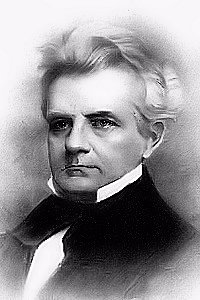Introduction

Born: January 8, 1792, Medfield, Massachusetts.
Died: August 11, 1872, at his home, Silver Spring,
in Orange, New Jersey.
Buried: Rosedale Cemetery, Montclair, New Jersey.




Born: January 8, 1792, Medfield, Massachusetts.
Died: August 11, 1872, at his home, Silver Spring,
in Orange, New Jersey.
Buried: Rosedale Cemetery, Montclair, New Jersey.



Lowell was the son of Johnson Mason and Caty Hartshorn, husband of Abigail Gregory, brother of Timothy Mason, and father of William Mason.
Lowell showed an intense interest in music from childhood. He lived in Savannah, Georgia, for 15 years, working as a bank clerk, but pursuing his true love—music—on the side.
He studied with Friedrich Leopold Abel, improving his skills to the point where he began composing his own music.
Numerous publishers in Philadelphia and Boston rejected his early work, until it was finally accepted in 1822 by the Handel and Haydn Society of Boston, Massachusetts, his native state. However, the collection did not even carry Mason’s name:
I was then a bank officer in Savannah, and did not wish to be known as a musical man, as I had not the least thought of ever making music a profession.
Little did he know that rejected
collection would eventually go through 17 editions (some sources say 21) and sell 50,000 copies. It was adopted by singing schools in New England, and eventually church choirs.
After seeing the success of his work, Mason returned to Boston in 1826. He also became the director of music at the Hanover, Green, and Park Street churches, alternating six months with each one.
He finally made a permanent arrangement with the Bowdoin Street Church, but still held his teller job at the American Bank.
Music continued to pull on him, though: He became president of the Handel and Haydn Society in 1827. And it was in Boston that Mason became the first music teacher in an American public school.
In 1833, he co-founded the Boston Academy of Music. In 1838, he became music superintendent for the Boston schools. Mason wrote over 1,600 religious works, and is often called the father of American church music.
The following sketch appeared 10 years after Mason’s death, in The Song Friend, Volume 3, number 5 (Chicago, Illinois: Solomon W. Straub, 5 March 1882), page 1.
Dr. Lowell Mason, the father of Henry Mason and Lowell Mason, of the Mason & Hamlin Organ Co., and Dr. Wm. Mason, the eminent composer, was born in Medford [sic], Mass., Jan. 8, 1792. At 21 years of age he removed to Savannah, Ga., where he remained for fourteen years; devoted himself to teaching vocal and instrumental music; was organist and choir-leader in one of the largest churches, and was also engaged in the service of one the banking houses.
At the age of 35 he returned to Boston, where for many years he was conductor of the Handel and Haydn Society. He also, in connection with Mr. George James Webb, established the Boston Academy of Music, the first regularly chartered music-school in the country, and introduced singing as a branch of instruction in the public schools.
Shortly after his return from the South he issued his first church music book, The Handel and Haydn Society’s Collection, followed by the Carmina Sacra and others which have been instrumental in popularizing the study of church music, and which completely revolutionized the character of the music in use in our churches.
He was for a long time intimately associated with Dr. Woodbridge, Horace Mann and other celebrated reformers in popular education, and devoted much time and labor to the instruction and training of teachers of singing in Normal schools established for that purpose.
The later years of his life were spent for the most part at his home, Silver Spring, in Orange, New Jersey, where he died August 11, 1872, at the age of eighty years.
Many people not personally acquainted with Dr. Mason fall into the mistake of attributing his success to a happy combination of circumstances, as the profession of music offered a comparatively new and unoccupied field of enterprise at the time he entered it.
The truth is, Dr. Mason would have been equally distinguished in any profession; he would have made a great lawyer, judge, or physician, had he chosen the profession of law or medicine.
He was not a great musician, perhaps in the technical sense. He was not a great singer or player or composer. But he was a great man; he had that keen, logical and analytical quality of mind which enabled him to go to the root of things. He saw that all genuine reform must begin at the foundation.
At the time he issued his first book for use in singing-schools the text books of musical notation contained only a confused jumble of obscure and contradictory statements, with a few exercises for practice, thrown together without much regard being paid to anything like orderly arrangement or method. Dr. Mason changed all this, and gave us a system of notation which for clearness of statement, and orderly, progressive arrangement, is unsurpassed.
No person could be brought into contact with Dr. Mason without feeling the influence of this strong personality, and we can safely say that this influence was always in the right direction. He had that simple dignity and nobility of character which seemed to stimulate and purify the purposes and aims of those who came under his influence. No man hated falsehood and shams more heartily than he, or detected and exposed them with greater keenness and certainty.